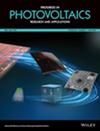Characterization, Accelerated Life Testing, and Finite Element Modeling of Low Temperature Solder Wire Interconnect Degradation Mechanisms
Abstract
Low-temperature soldered wire interconnection (LTSWI) is a technology utilizing many interconnect wires carried on a polymer foil to form electrical connections against cell gridlines without a separate soldering process. In this work, LTSWI module samples were characterized for material properties and assembly dimensions and subjected to accelerated aging experiments to induce degradation. A finite element analysis model was developed based on characterization results, to analyze internal stressors during environmental exposures. The polymer foil contains polyethylene terephthalate and low-density polyethylene layers, and solder composition was tin bismuth, which notably was not metallurgically bonded to cell gridlines. High temperature accelerated exposures created power loss up to 9% in minimodule samples, with fill factor losses implicating contact degradation. Posttest characterization identified solder-gridline cracking and wire-cell separation as contributing mechanisms. Finite element modeling demonstrated that wire-to-cell contact is maintained by polymer contraction post lamination but is reversible, resulting in contact loss and wire separation during high temperature exposure. Simulations also detected in-plane wire-to-cell displacements, driven by surrounding polymer motion in response to high temperatures and mechanical load. We hypothesize that the propensity for wire movement during environmental exposure damages the not-metallurgically bonded wire-gridline interface and contributes to LTSWI contact degradation. Because distinct from thermal expansion mismatches which damage traditionally soldered modules, current test protocols are likely not applying the intended acceleration factors to LTSWI modules. This work highlights how construction-specific accelerated testing may be needed for nontraditional module designs and provides a starting point for accurate LTSWI life assessment.


 求助内容:
求助内容: 应助结果提醒方式:
应助结果提醒方式:


